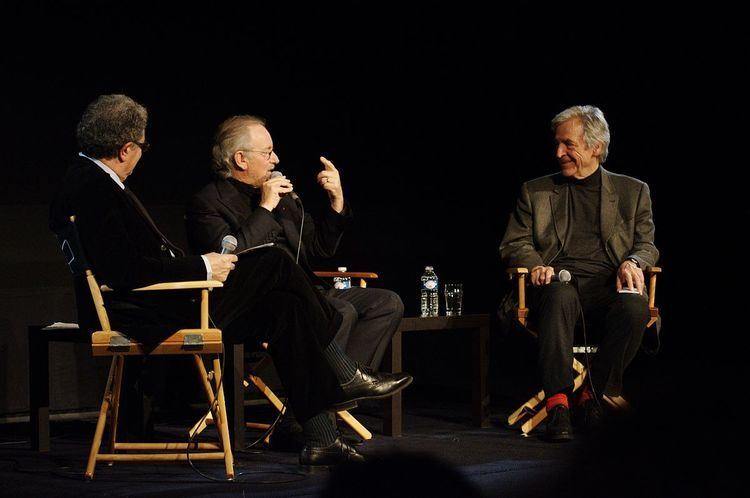Established 1936 Website www.cinematheque.fr Founder Henri Langlois | Purpose Film archive Phone +33 1 71 19 33 33 Architect Frank Gehry | |
 | ||
Headquarters 51 Rue de Bercy
75012 Paris, France Location Parc de Bercy, Paris, France Key people Henri Langlois
& Georges Franju
(Co-founders) Address 51 Rue de Bercy, 75012 Paris, France Hours Closed now Saturday12–7PMSunday12–7PMMonday12–7PMTuesdayClosedWednesday12–7PMThursday12–10PMFriday12–7PM Profiles | ||
Lettre ouverte la cin math que fran aise
The Cinémathèque Française ([sinematɛk fʁɑ̃sɛz]) is a French film organization that holds one of the largest archives of film documents and film-related objects in the world. Based in Paris, the archive offers daily screenings of worldwide films.
Contents
- Lettre ouverte la cin math que fran aise
- History
- The events of May 1968
- Location
- President Director and Secretary
- Tributes
- References
History
The collection emerged from the efforts of Henri Langlois in the 1930s to collect and screen films. Langlois had acquired one of the largest collections in the world by the beginning of World War II, only to have it nearly wiped out by the German authorities in occupied France, who ordered the destruction of all films made prior to 1937. He and his friends smuggled huge numbers of documents and films out of occupied France to protect them until the end of the war.
After the war, the French government provided a small screening room, staff and subsidy for the collection, which was first relocated to the Avenue de Messine. Significant French filmmakers of the 1940s and 1950s, including Robert Bresson, René Clément, Henri-Georges Clouzot and Jacques Becker frequented screenings at the Cinémathèque. Directors of the New Wave (la Nouvelle Vague) school — Alain Resnais, Jacques Rivette, François Truffaut, Jean-Luc Godard, Claude Chabrol, Roger Vadim, Jacques Doniol-Valcroze, and Pierre Kast — also received much of their film education by attending the collection's screenings.
The events of May 1968
In June 1963, the Cinémathèque had moved to the Palais de Chaillot with funds provided by André Malraux, Minister of Culture, and became subject to the government. In February 1968, under pressure from the Ministry of Finance, Malraux required changes in the management of the Cinémathèque and dismissed Henri Langlois.
A defence committee was formed, uniting the cream of French filmmakers (Alexandre Astruc, Claude Berri, Robert Bresson, Claude Chabrol, Jacques Doniol-Valcroze, Jean Eustache, Georges Franju, Abel Gance, Jean-Luc Godard, Joris Ivens, Pierre Kast, Chris Marker, Alain Resnais, Jacques Rivette, Eric Rohmer, Jean Rouch, François Truffaut) together with major actors (Jean-Pierre Léaud, Claude Jade, Jean Marais and Françoise Rosay). Foreign filmmakers such as Charles Chaplin and Stanley Kubrick added their support. Protests were organized.
Confrontations followed between young people, largely students, and what they saw as an authoritarian centre-right government, out of touch with the concerns of the younger generation. These demonstrations were precursors of and merged into the widespread student revolt that erupted from March 1968 onwards, escalating into nationwide unrest in May. Before then, the government had backed down over the Cinémathèque, reinstating Langlois as head in April 1968.
Location
After numerous incidents — including multiple relocations from one small screening room to another through the 1950s and a fire in its last premises — the Cinémathèque Française moved to 51, rue de Bercy in the 12th arrondissement of Paris and reopened its doors in a postmodern building designed by Frank Gehry, an American architect. A restaurant on the lower level is open to the public.
The Bibliothèque du Film, which was created in 1992 to show the history of cinema, its production, impact and artistic strength, has recently merged with the Cinémathèque Française.
Cinémathèque Française operates the Musée de la Cinémathèque, formerly known as Musée du Cinéma – Henri Langlois, in the new building.
President Director and Secretary
Tributes
In celebration of the Centennial of the Metropolitan Museum of Art, the Museum and the City Center of Music and Drama in New York co-sponsored “Cinémathèque at the Metropolitan Museum.” The exhibition showed seventy films dating from the medium’s first seventy-five years on thirty-five consecutive evenings from July 29 to September 3, 1970. The films were selected by Henri Langlois for their significance and contributions to the history of filmmaking, including work from official film industries as well as current and early avant garde directors. The program was the most diverse film exhibition held in the United States to date, and was the Museum’s first major undertaking in film.
The Cinémathèque's closing is noted in Truffaut's Stolen Kisses. The Cinémathèque also appears in the Paul Auster novel The Book of Illusions and the Harvey Danger song "Private Helicopter."
